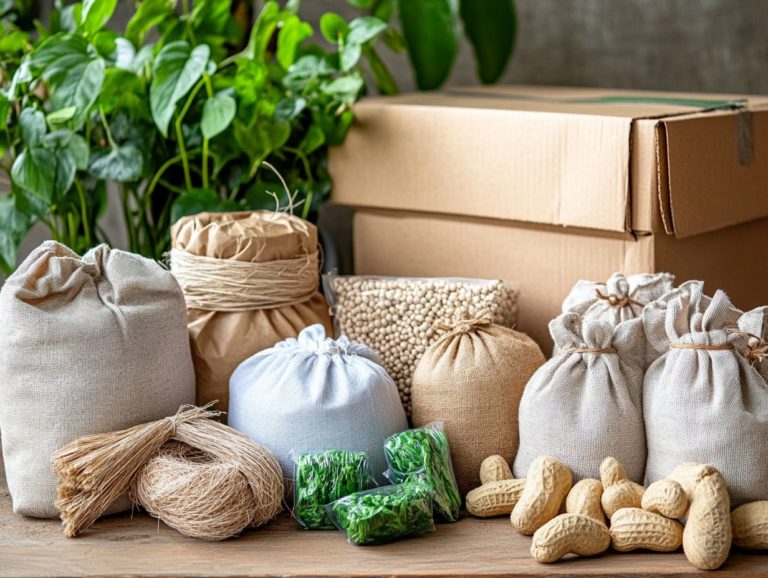What Are the Best Practices for Wildlife Tourism?
Orchids, with their breathtaking blooms and exquisite forms, are a true delight for any plant enthusiast. Successfully propagating these remarkable plants can be immensely rewarding, whether you aim to expand your collection or generously share them with friends.
This guide will walk you through the finest techniques for orchid propagation, including seed, division, and keiki (small plantlet that forms on the parent plant) propagation. You will also find a discussion of the essential tools you need, step-by-step instructions, troubleshooting tips, and guidance on how to care for your newly propagated orchids.
Prepare to cultivate your gardening skills and elevate your gardening experience!
Contents
Key Takeaways:

- Choose the right method for propagating orchids, including seed, division, or keiki propagation. Each method has its own benefits and requirements.
- Essential supplies such as sterilized tools, potting mix, and rooting hormone are necessary for successful orchid propagation. Optional tools like heat mats and grow lights can also be used for advanced techniques.
- Proper preparation, techniques, and post-propagation care, such as transplanting and continued maintenance, are crucial for healthy and thriving newly propagated orchids.
What is Propagation?
Propagation is the fascinating process of creating new plants from existing ones. It s particularly vital for you as an orchid enthusiast aiming to expand your collection of these exquisite flowers.
There are two primary types of orchids you ll encounter: symphodial orchids, like cymbidiums and cattleyas, and monopodial orchids, such as phalaenopsis and dendrobiums. Engaging in this process can involve various techniques, including seed propagation, division, and keiki removal, all of which ensure the continuous growth and blooming of these stunning plants.
Understanding the distinctions between sympodial and monopodial orchids is key to your success in orchid care. Sympodial orchids grow horizontally, sending out multiple growths from a single base, which makes division a practical propagation method.
On the other hand, monopodial orchids grow vertically, featuring a singular stem that keeps reaching for the sky. They often necessitate keiki removal for propagation.
Each method comes with its unique benefits and challenges, allowing you to choose the technique that best fits your orchid type. Mastering these propagation methods not only nurtures a flourishing orchid collection but also plays a critical role in preserving the rich diversity of orchid species, making it an essential pursuit for every passionate grower like yourself, especially when considering plant division and techniques for caring for new growth. Additionally, exploring the best practices for propagating carnivorous plants can further enhance your gardening skills.
Methods of Propagating Orchids
You have a variety of effective methods at your disposal for propagating orchids, each tailored to different species and growth conditions. This will help you cultivate a healthy and vibrant collection.
Among the most common techniques is seed propagation, which necessitates a sterile environment and a specialized orchid potting medium. For sympodial orchids, division propagation is the way to go, while keiki propagation involves delicately removing the keikis that sprout from the parent plant and nurturing them into thriving orchids. To learn more about these methods, check out the effective propagation techniques for indoor plants.
Seed Propagation
Seed propagation is an interesting but challenging method of growing orchids, requiring specialized knowledge and optimal conditions to thrive. Unlike many other plants, orchid seeds are diminutive and devoid of the nutrients found in larger seeds, making it essential for you to select a high-quality orchid potting medium and maintain a pristine environment to encourage germination and growth.
Along with choosing the right medium, establishing a sterile workspace is critical to prevent contamination that could impede your delicate seedlings. Many enthusiasts encounter challenges such as mold growth or disappointing germination rates, often due to insufficient environmental controls.
By understanding the specific moisture and light requirements of orchid seeds, you can effectively address these issues. As an aspiring orchid grower, patience and attentiveness are paramount.
The entire process may be demanding, but the joy of seeing your new seedlings flourish under ideal conditions is truly gratifying.
Division Propagation
Division propagation is a simple and effective technique for sympodial orchids. You ll love how easy it is to create multiple plants from a single orchid by dividing its root ball. This method involves gently separating the plant into sections. Each division should have healthy back bulbs and roots, setting the stage for new growth and better blooms.
To get started, gather a few essential tools: a sterilized knife or scissors, pots with drainage holes, and fresh potting mix designed for orchids. Look for a blend of bark, sphagnum moss, and perlite.
Next, choose the perfect moment for division, preferably during the orchid s active growing season. Carefully inspect the plant to find sections ready for division while protecting the root system and any attached pseudobulbs, which are special storage organs that help the orchid survive.
After making your divisions, allow the cut ends to callous slightly before re-potting. This crucial step helps prevent rot. Once you ve divided the plant, give it the right care such as bright, indirect light, optimal humidity levels, and watch out for overwatering to help your new divisions thrive.
Keiki Propagation

Keiki propagation is an exciting method that allows you to nurture the natural growth of keikis sprouting from the parent plant. It s a delightful way for orchid enthusiasts like you to cultivate new orchids with ease. When you carefully remove the keiki after it has developed enough roots, you can transplant it into its own potting medium for rapid growth.
Wait until the keiki has at least two or three robust roots, ideally about three inches long. This timing is crucial for ensuring that your young plant can independently access moisture and nutrients.
Once you ve detached the keiki, put it in a well-draining potting mix that contains organic materials. Keep the new plant in a humidity-rich environment and provide it with indirect sunlight to encourage healthy growth.
Regular misting and careful monitoring for pests and aerial roots will enhance its development. Start your propagation journey today and watch your orchids thrive as they embark on their exciting independent journey!
Tools and Materials Needed
For successful orchid propagation, having the right tools and materials is essential. This not only boosts your success rate but also promotes the health of your plants.
Key supplies include:
- a sterilized knife for clean cuts during division,
- a spade for digging up roots,
- high-quality orchid potting medium to nurture new growth.
You may also use a fungicide to prevent diseases throughout the propagation process.
Essential Supplies
Essential supplies for propagating orchids include a high-quality orchid potting medium, a sterilized knife for precise cutting, and a controlled, clean environment to facilitate growth. These items are fundamental for ensuring that your propagated orchids flourish, minimizing the risk of disease and promoting strong root development.
Choosing the right potting medium is crucial. It provides the necessary air circulation and moisture retention for healthy growth. Seek out a mix specifically formulated for orchids, typically made of bark, perlite, or sphagnum moss.
A sharp, sterilized knife allows you to make clean cuts, reducing trauma to the plant and limiting the risk of infection. Maintaining stable temperature and humidity levels is vital. Consider using a humidity dome or a propagation station to create the best setting.
By focusing on these high-quality materials and conditions, including the use of a fungicide, you can set the stage for successful orchid propagation. Your beautiful plants will flourish beautifully!
Optional Tools for Advanced Techniques
Optional tools for advanced orchid propagation techniques can significantly enhance your success. They help manage both plant health and growth.
While using fungicide a substance used to kill fungi that can harm plants is not mandatory, it can certainly be helpful in preventing infections. Consider incorporating tools like humidity domes and misting systems, which are very useful for maintaining optimal conditions tailored to different orchid sizes.
These devices work to create a controlled environment. They ensure that humidity levels are just right for root development crucial for nurturing young orchids.
Grow lights can mimic natural sunlight, providing the essential spectrum for photosynthesis, allowing your orchids to thrive even in indoor settings.
You should also consider using pH meters to monitor how acidic or basic your growing medium is. This helps ensure it remains within the ideal range for maximum nutrient absorption. Collectively, these tools not only promote healthy growth but also significantly boost your chances of successful propagation, enabling you to cultivate an impressive collection of orchids.
Step-by-Step Guide to Propagating Orchids
A comprehensive step-by-step guide to propagating orchids offers a wealth of techniques and best practices meticulously tailored to each specific orchid type. This paves the way for successful growth and vibrant blooms.
Grasping the unique care requirements for each propagation method is crucial in your pursuit of cultivating healthy new plants whether you choose to propagate through seed, division, or keiki. For those interested in efficiently propagating orchids, understanding the differences between sympodial orchids and monopodial orchids can be beneficial.
Preparation and Set-Up

Preparation and set-up are pivotal in orchid propagation, serving as the foundation for robust growth and successful outcomes. This requires you to create a pristine environment, select the right orchid potting medium, and gather all the essential tools for a seamless propagation process.
Start by meticulously cleaning your workspace to eliminate any harmful bacteria or pests that could threaten your delicate orchids. Disinfect your tools and surfaces to ensure everything is sterile and ready for action.
Next, choose a potting medium crafted specifically for orchids, such as a blend of bark, sphagnum moss, or perlite. This mix is fantastic for ensuring your orchids get the best drainage and airflow for healthy growth!
Gathering essential tools like sterilized pots, scissors, and labels will streamline the process. Taking these steps now will set you up for a thriving orchid collection!
Techniques for Each Method
Each method of orchid propagation demands specific techniques for success, whether you’re diving into division propagation or exploring keiki propagation. By grasping the nuances of each approach, you can customize your strategy to ensure your orchids flourish with healthy new growth and stunning blooms.
To propagate by division, carefully separate a mature orchid into smaller sections. Each section should have roots and at least one healthy pseudobulb. It’s best to tackle this during the plant’s active growth season to minimize stress on the plant.
On the flip side, keiki propagation involves waiting for a new plantlet to form on the flower spike. A gentle touch is key. Wait until the keiki has developed a few roots before detaching it. Using sterile tools throughout these processes is crucial to reducing the risk of infection.
Additionally, maintaining optimal humidity and light conditions is crucial for success.
Troubleshooting Common Issues
Troubleshooting common issues in orchid propagation is crucial for maintaining the health of your plants and ensuring their successful growth. By identifying problems early be it root rot, insufficient light, or pest infestations you can take proactive measures to enhance your orchid care.
This vigilance not only improves the well-being of your orchids but also significantly increases the likelihood of achieving beautiful blooms.
Identifying and Addressing Problems
Identifying and addressing problems during orchid propagation can significantly enhance your success rates and plant health. Overwatering, insufficient light, and inadequate potting medium can impede growth. It s essential to tackle these issues promptly for optimal orchid care.
To resolve these problems, one effective strategy is to closely monitor your watering schedule. Make sure the growing medium provides good drainage while still retaining some moisture. Providing just the right amount of light typically bright, indirect sunlight will encourage healthier growth and flowering.
Regarding potting medium, choosing a mix specifically designed for orchids can make a big difference. Regularly inspecting the roots for signs of rot or stress, along with adjusting humidity levels, will further boost your chances of successful propagation. By understanding and proactively addressing these factors, you can cultivate thriving orchids that truly flourish.
Maintaining and Caring for Newly Propagated Orchids
To help your newly propagated orchids thrive, take a thoughtful approach to ensure their healthy establishment and growth. Once you’ve successfully transplanted them, ongoing care becomes essential.
Focus on key factors like light, humidity, and nutrient supply. These elements significantly influence your plants’ development and overall health. Attention to these details will set the stage for flourishing orchids that thrive in your care.
Transplanting and Continued Care

Transplanting newly propagated orchids demands your careful attention to their unique needs and growth conditions for a seamless transition. After transplanting, proper orchid care becomes essential, so keep an eye out for new growth and adjust the environmental conditions to foster healthy development.
Timing is of the essence here. Late winter or early spring typically presents the best window for transplanting, aligning beautifully with the plants’ natural growth cycle. Start by selecting the right potting media something that provides excellent aeration and drainage, like a mix of pine bark and sphagnum moss.
When you’re ready to transplant, gently remove the orchid from its original pot and delicately separate the roots, ensuring you don t inflict any damage. Once positioned in the new pot, fill any gaps with your chosen media, providing stability without compacting it too tightly.
After the transplant, ensure there s adequate humidity and moderate light; this will help the orchids adjust and promote healthy growth. Keep a vigilant eye out for signs of stress or disease, as regular monitoring will significantly enhance the success of this crucial step in orchid care.
Frequently Asked Questions
What are the best techniques for propagating orchids?
The best techniques for propagating orchids include division, stem cuttings, and keiki propagation, which is when you grow new plants from the baby orchids that develop on mature plants.
When is the best time to propagate orchids?
The best time to propagate orchids is during their active growth phase, which is typically in the spring or early summer.
Do I need any special tools or equipment for propagating orchids?
While not necessary, some helpful tools for propagating orchids include sharp scissors or pruning shears, rooting hormone, and clean pots or containers.
Can I use water to propagate orchids?
Yes, some orchid varieties can be propagated in water, but it is recommended to use a well-draining potting mix for better success.
How long does it take for orchids to propagate?
The time it takes for orchids to propagate can vary depending on the method used, but generally, it can take several weeks to a few months for new growth to appear.
Ready to try your hand at orchid propagation? Gather your tools and start today!
Can I propagate orchids from leaf cuttings?
Yes, some orchids can be grown from leaf cuttings.
Keep in mind, this method might not always work as well as others.
Curious how to do it? Let s explore!






